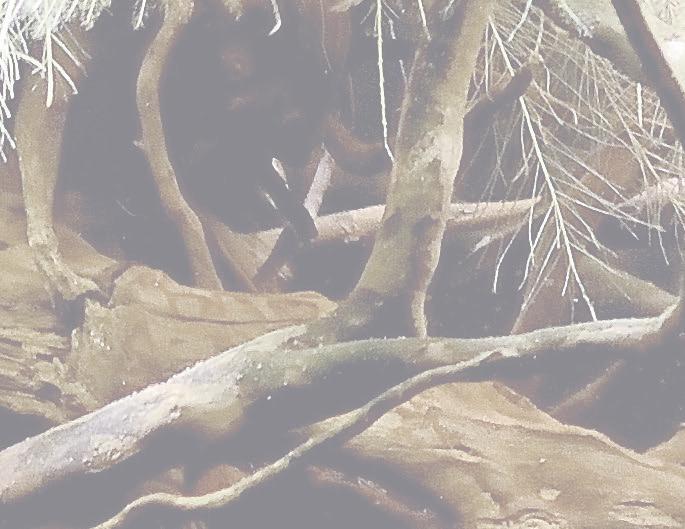
11 minute read
Snakes – sacred and cursed creatures (part 2) – Dawid Krótki
Lampropeltis triangulum hondurensis freshly hatched from an egg
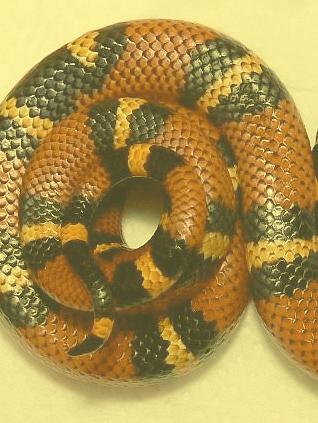
Advertisement
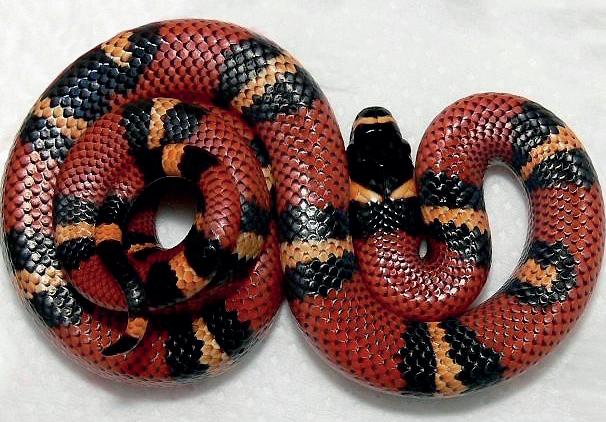
SNAKES SACRED AND CURSED CREATURES (PART 2)
Dawid Krótki
A graduate of the Faculty of Animal Breeding and Biology at the University of Agriculture in Krakow. Breeder of African and South American cichlids. An expert in the feeding and breeding of reptiles, amphibians and all kinds of invertebrates. Author of many aquarium and terrarium articles.
Nearly 2700-3000 snake species live on Earth today. They can be found in almost all environments, both in the desert and in the humid equatorial forests. They live in or on the soil, as well as high in the tree crowns and in the sea. Contemporary classification is based on phylogenetics (if known), and in those groups where the knowledge of evolution is insufficient, it is complemented by a certain amount of theoretically based speculation or artificial groups are created. This article will discuss the anatomical features of snakes on the example of selected families from the Serpentes suborder.
LEPTOTYPHLOPIDAE – SLENDER BLIND OR THREAD SNAKES Leptotyphlopidae family includes 2 genera and about 90 snake species. The cranium and upper jaws consisting of maxilla, palatine bone and pterygoid are immobile, the teeth (4-5) are only found on a relatively large dental bone, the lower jaw consists of a huge quadrate bone lying horizontally, a small complementare, angular bone, coronoideum and spleniale. Pelvic gridle is vestigial, some African species have small external anal spurs. They do not have the left lung, tracheal lung and left ovary. Eyes are larger and better developed than in Typhlopida. All Leptotyphlops species have a distinct pupil. They are usually beige or pink, and the majority is not pigmented at all, and their colour is the effect of visible blood vessels. The average length of Leptotyphlopidae does not exceed 15 cm. They are all egg-bearing and lay from 1 to 12 oblong eggs.
TYPHLOPIDAE – BLIND SNAKES The family Typhlopidae comprises 7 genera and over 220 species. These are snakes adapted to living underground. The dorsal and abdominal parts are covered with fine, uniformly sized scales, with a large
Large, convex scales and the head vaguely separated from the trunk in Naja pallida

rostral plate that looks like a nail visible on the head. Eyes are vestigial and barely visible under the scales. They have upper jaw with teeth (several teeth on the maxillary bones) and toothless premaxillae bones. The lower jaw is made up of a huge complementare, a large coronoideum and a small angular bone and a spleniale (small toothless dentary bone). In Typhlopidae, the left lung is usually absent or vestigial. The right lung is multi-chamber with the exception of Xenotyphlops. They do not have left fallopian tube and have only vestigial pelvic girdle. The total length of these snakes ranges from 10 to 95 cm, on average about 35 cm. The tail is short, 1-3% of the total length, often thick-
Internal systems of the female Boa constrictor
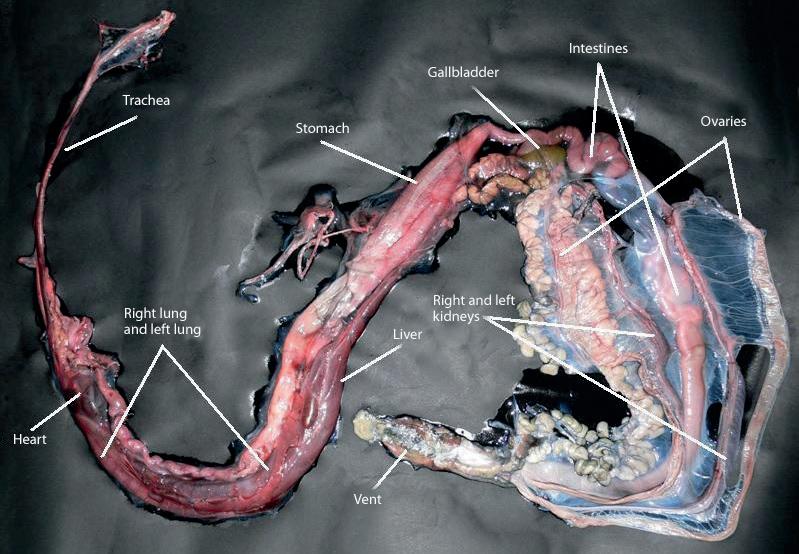
er than the rest of the body and ending in a sharp spike. Some egg-bearing females may keep eggs in their reproductive tract for longer periods. One species is probably ovoviviparous. Common blind snake is parthenogenic. BOIDAE – BOIDS OR BOAS The Boidae family comprises 11 genera and about 38 species. The total length of these snakes ranges from 30 cm to 9 m. They have vestigial pelvic girdle and vestigial hind limbs in the form of claws on tigial hind limbs in the form of claws on both sides of the cloaca. Males’ claws are both sides of the cloaca. Males’ claws are

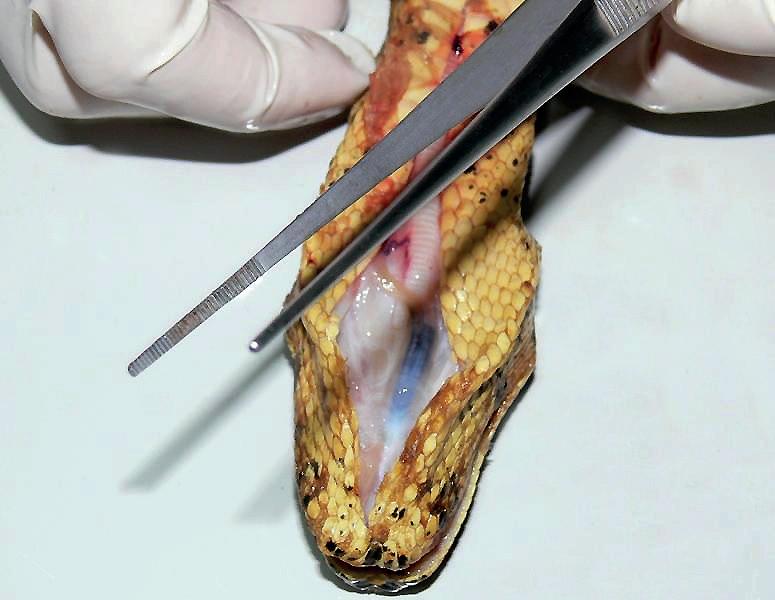
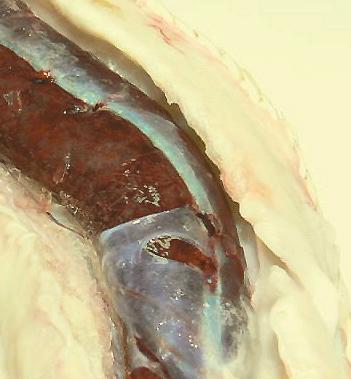
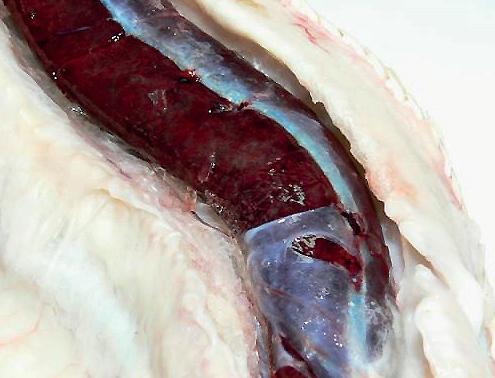
Internal systems of the male Boa constrictor
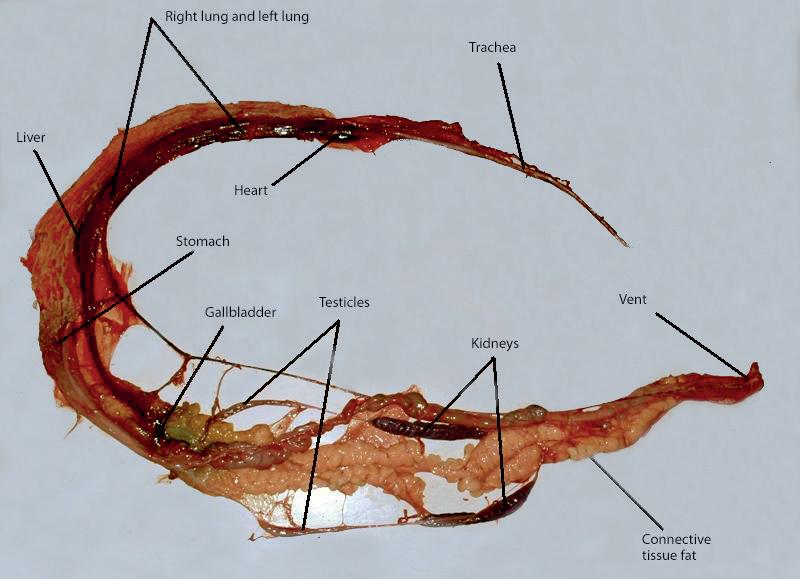
Boa constrictor’s internal stomach wall
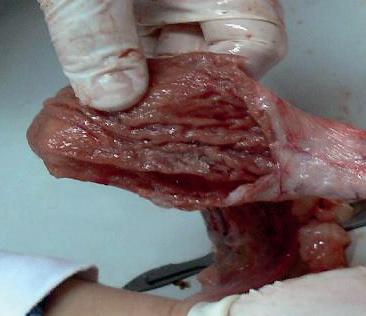
usually larger and are often used to stimulate the female before copulation. They have the right lung but their left lung is well or moderately developed. There is no tracheal lung. Left and right ovaries are well developed. In boa constrictor for example, the heart is located at 59th-66th ventral scale, right lung (64-129), left lung (66-98), liver (71-121), gallbladder (132-138), pancreas (134-136), right kidney (155-172), left kidney (161-174). Most Boidae have toothless premaxilla in the coronoideum. Most Boas have infrared receptors located in labial scales. Their pupil is vertical. Most boids are ovoviviparous, only Calabaria reinhardtii, Gongylophis muelleri and Eryx jayakari lay eggs.
PYTHONIDAE – PYTHONS The Pythonidae family comprises 8 genera and 33 species. The body length of these snakes ranges from 50 cm to 9 m. In the skeleton, the vestigial shoulder girdle and two vestigial hind legs are larger in males and play a similar role as in boids. Most of the species have infrared recep-
tors in labial scales with the exception of both Aspidites species. Left lung is slightly smaller than right and there is no tracheal lung. Pythons differ from boids by an even anal plate and a few details in the cranium structure, for example, they have teeth on the premaxillary bones (the exception is the Aspidites). Pythons are egg-bearing, the number of eggs ranges from 4 to about 100. When the eggs are laid they are soft and sticky but in contact with air they stick together to form a lump around which the female is then wrapped.
COLUBRIDAE – COLUBRIDS Colubridae is a huge and quite diverse family, containing about 300 genera and over 1800 species. They are often called “typical” snakes. The length of their body varies from several centimeters to 3.5 m. Within individual subfamilies there are both snakes without venomous teeth (Aglypha type of dentition) and with enlarged back teeth (Opistoglypha). As a rule, they are not considered venomous, but more than seven hundred spe-
Many boids lead a remarkably arboreal lifestyle. They have a slender, laterally flattened body and a long, catchy tail
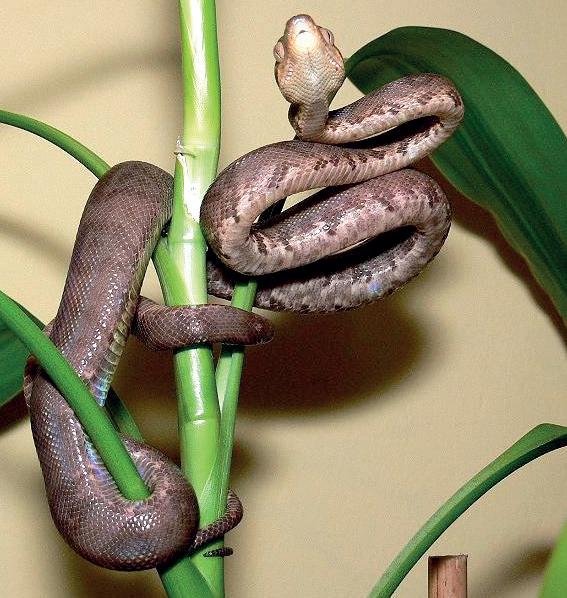
cies have a developed Duvernoy’s gland, an even gland located on both sides of the upper jaw in the postocular region, which at the front changes into a supralabial gland. Although this gland is homologous to the venous glands of elapids and vipers, it shows anatomical and functional distinctiveness. As a rule, there is no large internal venom tank, and venom
Pythons, like boids, have a lot of strong muscles adapted to suffocation. Here Python molurus bivittatus is eating a hen
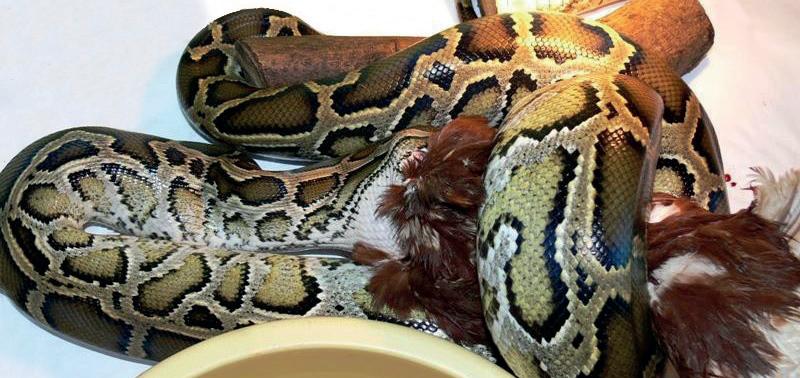
Eggs of Lampropeltis triangulum hondurensis
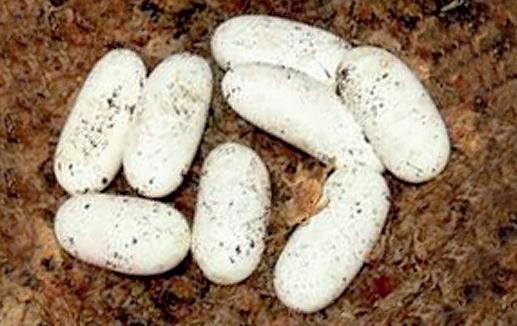
is not transported through venom teeth equipped with an internal canal. Usually these snakes also do not have specialized, jaw striated muscles, so venom cannot be injected into the victim’s body, but as a result of a grip on the jaws it flows down to the wound inflicted with teeth (only Dispholidus typus and representatives of the Mehelya genus have such muscles). Venom is usually not a threat to humans, although fatal accidents happen occasionally. The top of the head is usually covered with enlarged scales. The pupil is round or vertical. The genus Cerberus has a unique salt gland.
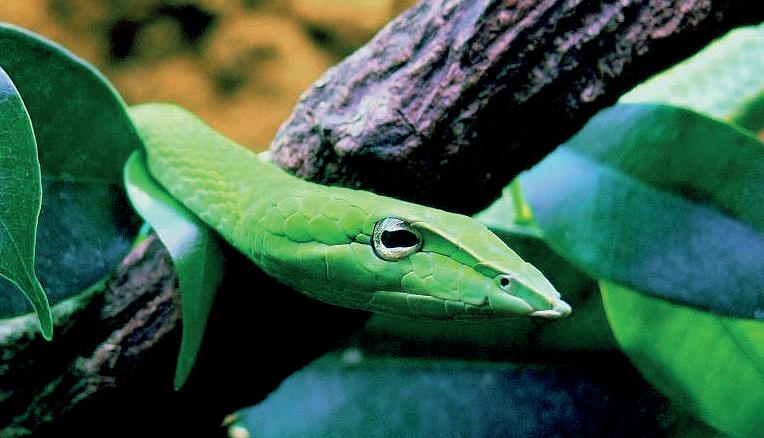
ELAPIDAE – ELAPIDS Elapidae has two subfamilies: Elapinae, consisting of 18 genera and more than 150 species, Hydrophiinae from Australia and Melanesia, consisting of 30 genera and about 100 species and 16 genera and more than 60 species of sea snakes. They are all venomous. Their venom is mainly neurotoxic. Postsynaptic neurotoxins are present throughout the family and some representatives also have cardiotoxins. Some species of elapids are among
The eyes of Ahaetulla nasuta allow it to see very precisely
the most venomous snakes in the world. In the front part of the upper jaw there is a pair of fixed venomous teeth with a sheat pocket (Proteroglypha fangs). If a fang is lost, its function is taken over by
A rattle formed on the tail of Crotalus atrox
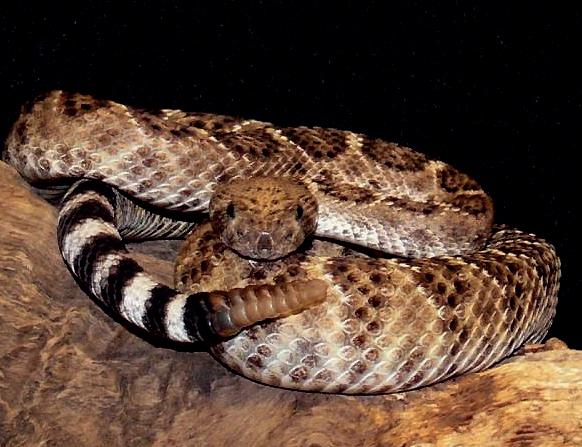
the next in line. The body of these snakes is elongated and slender. The scales are large and overlapping. The head is usually the width of the trunk. Its top is equipped with large, clear scales.
VIPERIDAE – VIPERS Viperidae is the most specialized family, comprising 35 genera and over 250 species. These are venomous snakes, their venom is mainly hemotoxic. At the front of the upper jaw there are long fangs with an internal venom channel (Solenoglypha fangs). These teeth are fi xed on movable jaw bones and fold backwards when the snake is closing the jaw. The head is usually triangular in shape, wide, with fi ne scales on the whole surface, without heat pits (except for Crotalinae). The body of these snakes is massive, often very thick, with a short tail. There are both ovoviviparous and egg-bearing species. In some Crotalinae from the New World there is a rattle at the end of the tail, formed from the remaining, keratinized segments formed as a result of succession of molts.
SUMMARY Snakes appeared on Earth more than 145
Thermosensitive cavities between nostrils and eyes in Crotalus durrisus vegrandis
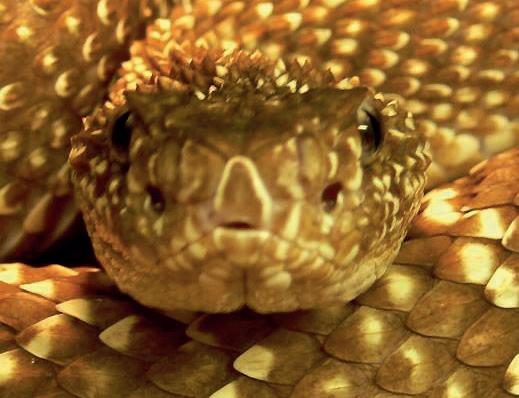
million years ago and today there are over 3000 species in the world. People have always been intrigued by these reptiles, especially their original structure, biology, the way they move or hunt. This is due to numerous anatomical conditions that have developed in snakes through evolution. There has been a loss of extremities as a result of the regress and an increase in the number of vertebrae, which (as in the case of Varanidae) have additional joint surfaces. The construction of their internal systems is different from that of their closest relatives – lizards (Sauria). Most snakes have only one lung – right, the more primitive ones also have a vestigial left lung. Furthermore, the even organs of these reptiles have been displaced relative to each other. The reproductive and excretory system in males are as follows: the right testicle is located most cranially, then on the left side, in the middle of the right testicle, there is the head of the left testicle. Each testicle has its own vas deferens, leading the semen to the hemipenis sac. Behind the testicles caudally there is the right kidney, further behind it, in analogy to the testicles, there is the left kidney. Along
each kidney there is a collective canal. Physiological processes related to metabolism are also worthy of attention, as snakes swallow the victim in whole and digest all of his tissues perfectly, with the exception of epidermal products such as hair, claws. During the victim’s digestion, the stomach produces huge amounts of acids, the liver enlarges many times, as does the heart muscle. The whole body works at top speed. And it needs the right temperature for that. Snakes are cold-blooded, which means they do not maintain a constant body temperature, and that’s why they take sunbathing to regulate it. However, the greatest achievement in the evolution of this group of animals is the formation of venom apparatus, consisting of glands, venom channels and fangs. The Viperidae family has the best venom apparatus. The vipers are the ones which most often cause death or permanent damage to health.
Literature
Bruins E., Encyklopedia terrarystyki, Wydawnictwo Galaktyka, Łódź 2003. Coborn J., Atlas węży świata, Wydawnictwo Muza S.A., Warszawa 1993. Dobrowolska H., Gady, wydanie II – zmienione, Państwowe Wydawnictwo Naukowe, Warszawa 1990. Jaroniewski W., Jadowite węże świata, wydanie piąte. Wydawnictwa Szkolne Pedagogiczne, Warszawa 1992. Marais J., Wielka księga węży, Wydawnictwo Książkowe Twój Styl, Warszawa 1997. O’Shea M., Venomous snakes of the world, New Holland, London 2005. Sura P., Encyklopedia współczesnych płazów i gadów, Wydawnictwo Fundacja, Nowy Sącz 2005. Gumprecht A., Toenjes E., Die Tempelotter – Tropidolaemus wagleri, Natur-und-Tier-Verlag, Münster 2007.
Photos by: Dawid Krótki
Top quality organic coconut substrates for snakes
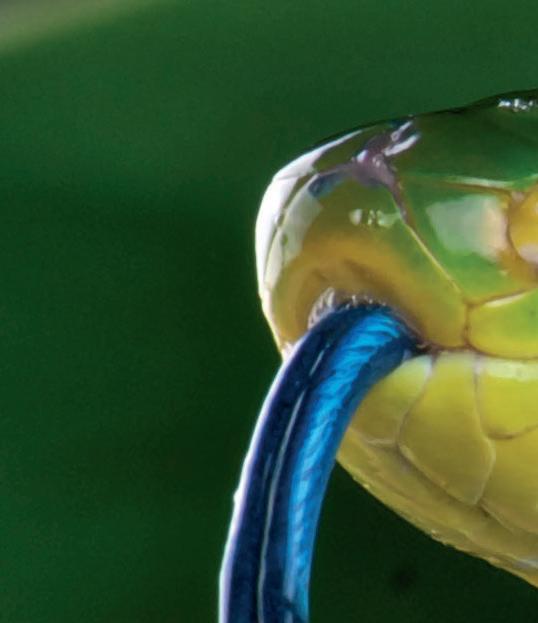
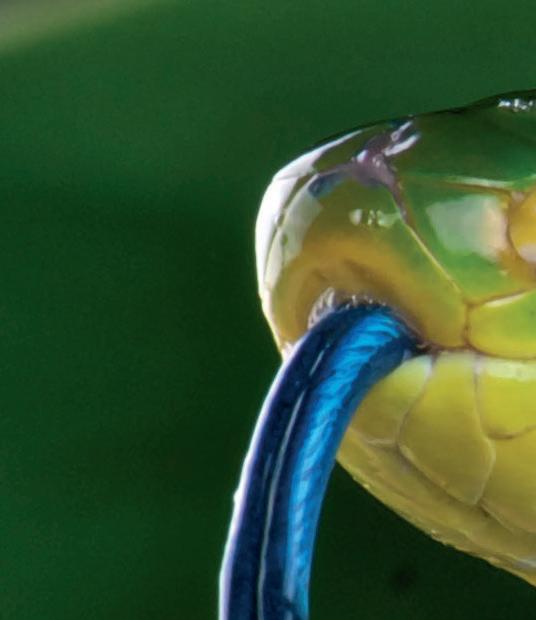
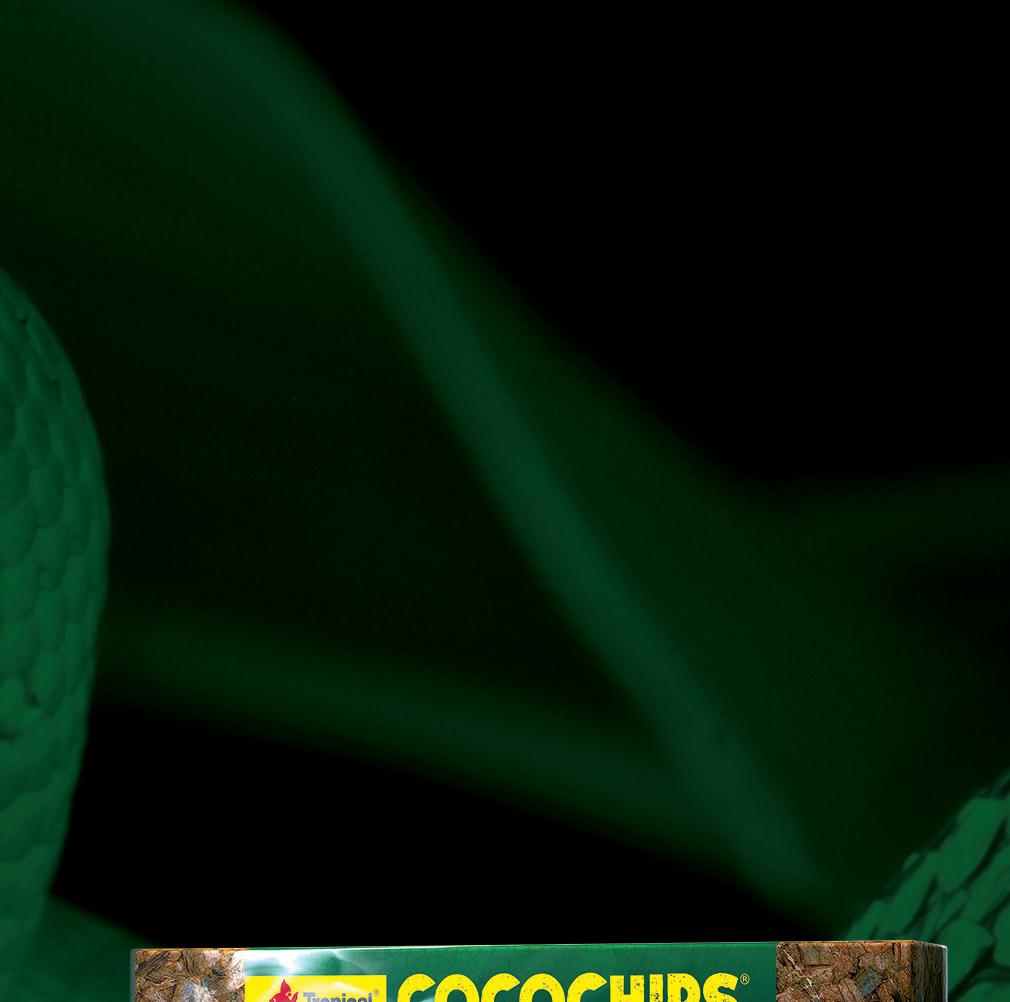
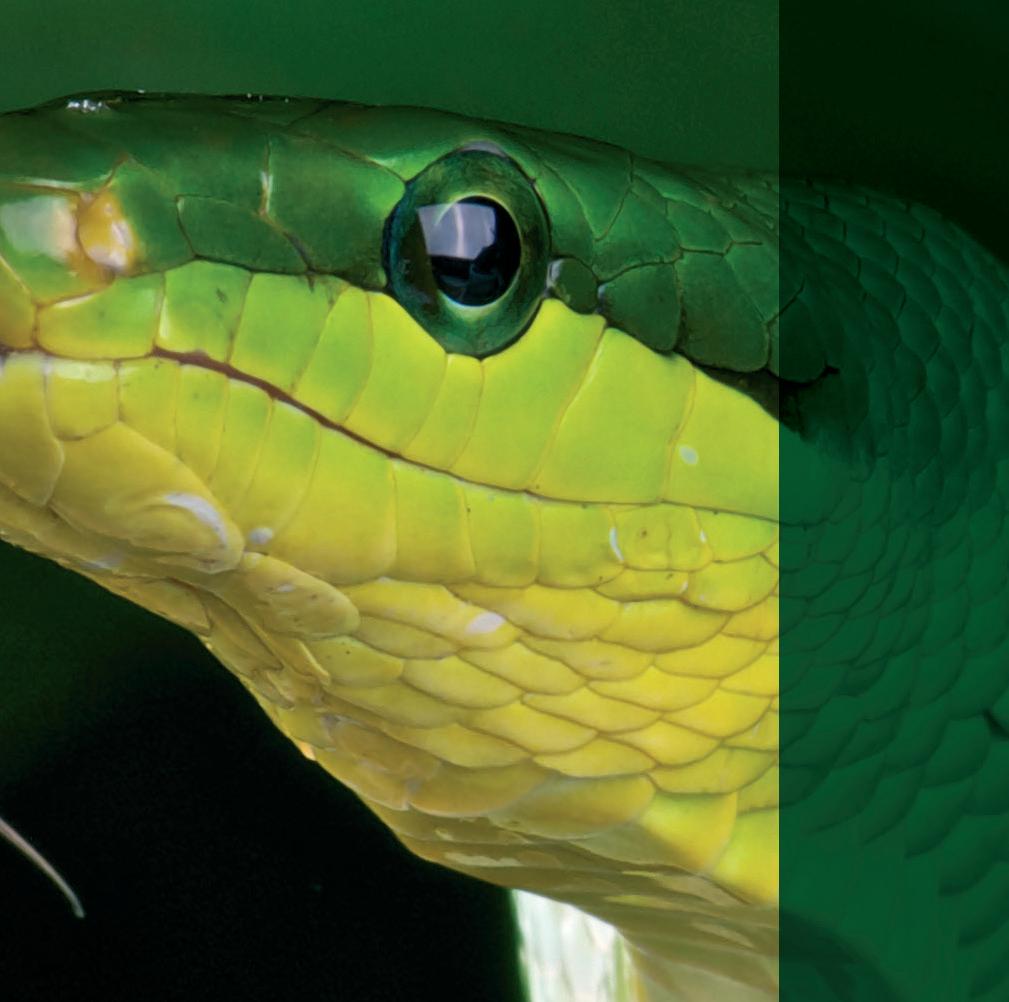
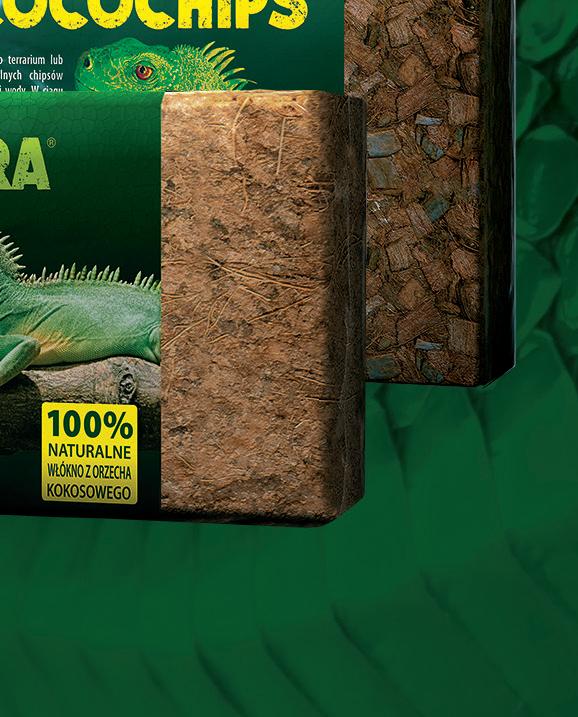
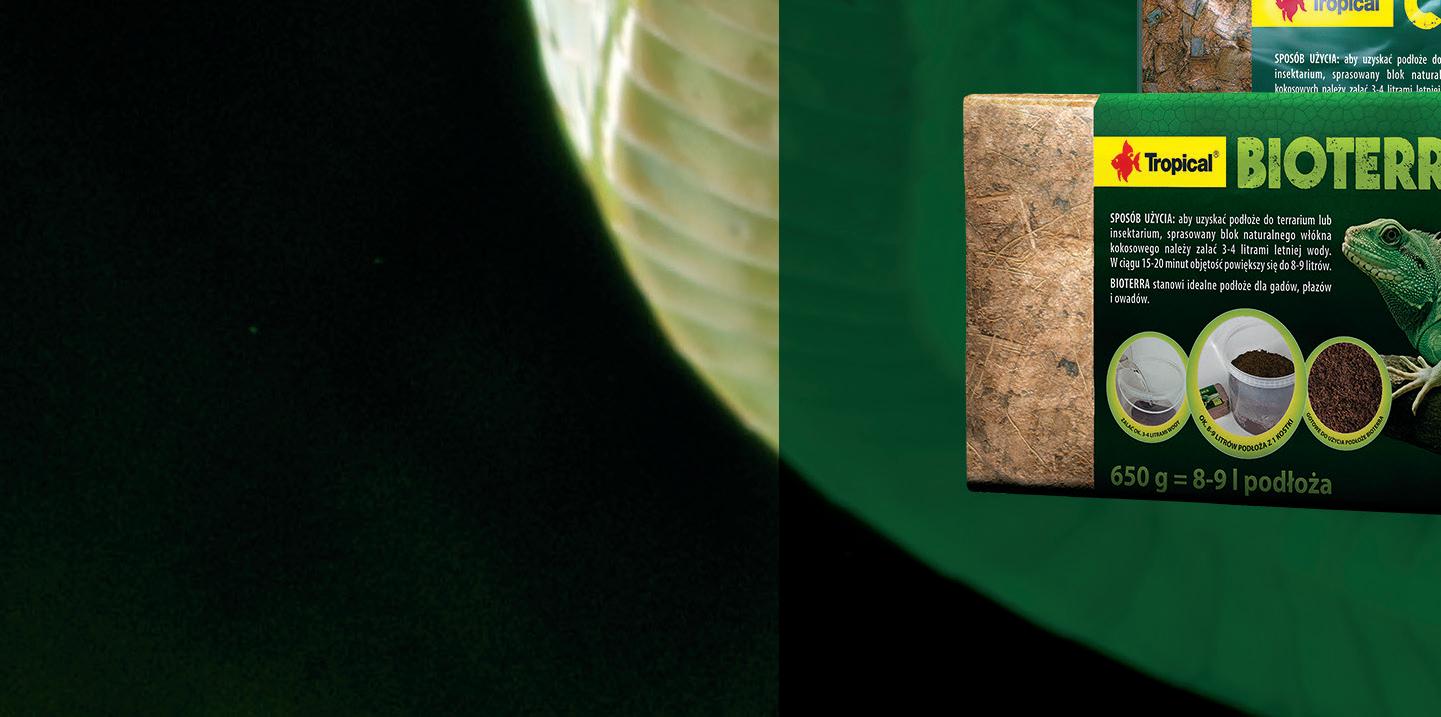
HERRING • CALANUS • KRILL • INSECTS • ALGAE
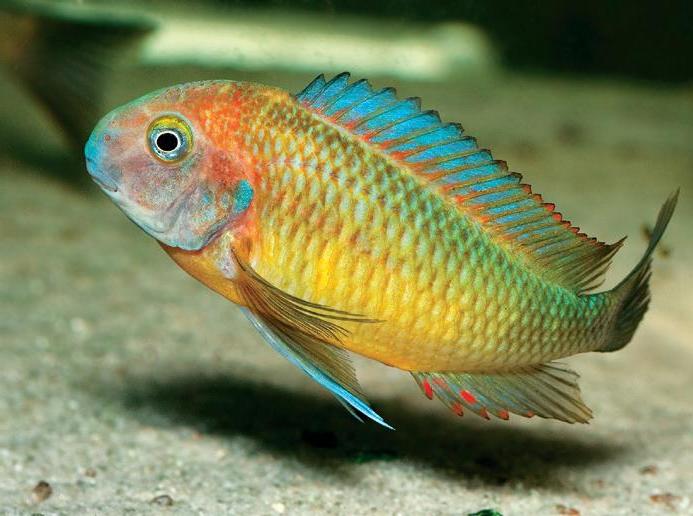
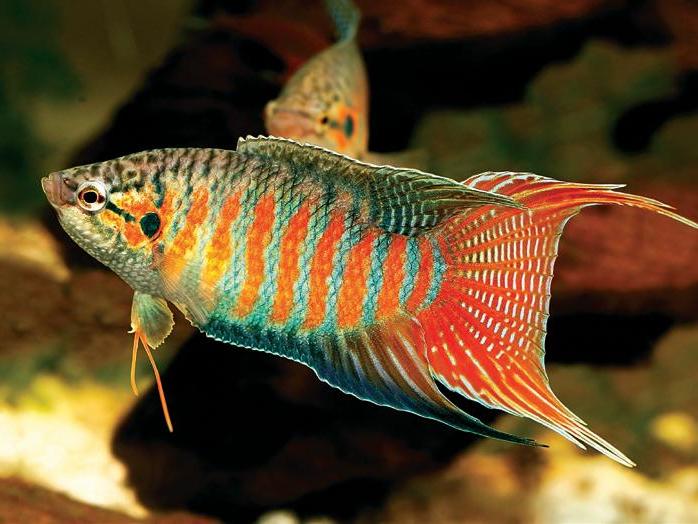
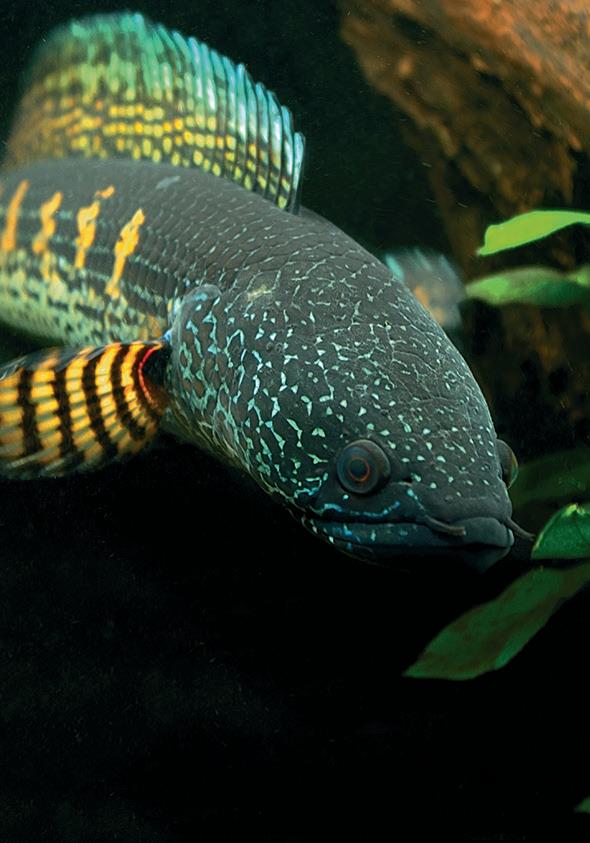




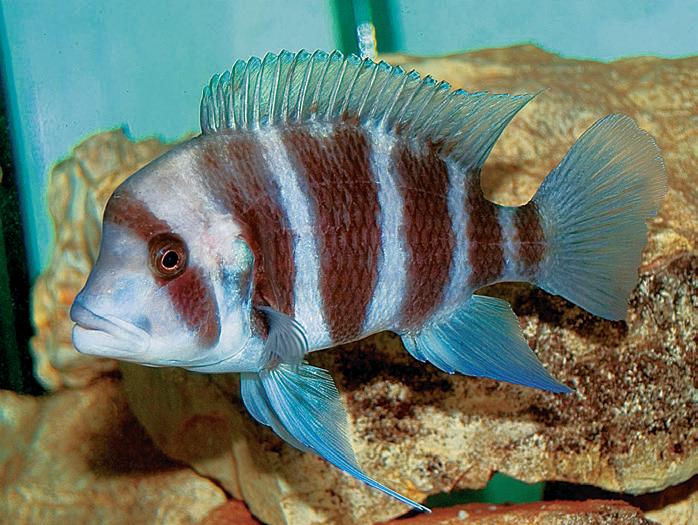
Innovative soft granules concept
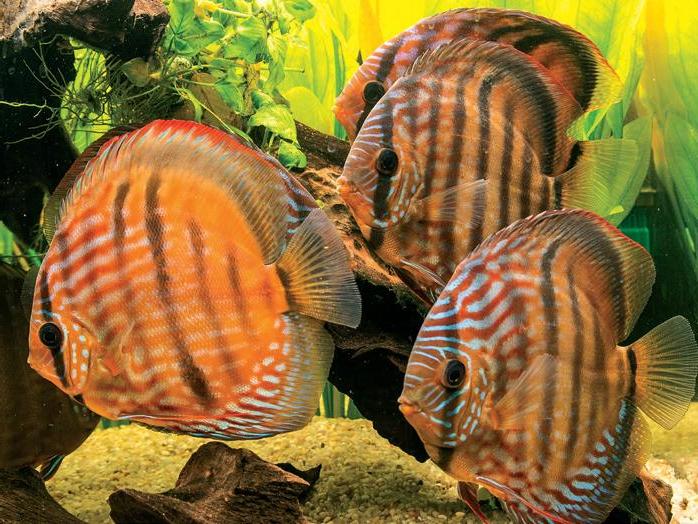
The Soft Line includes granulated foods of a unique soft texture. They ensure excellent condition, intensive growth and coloration in fish.
exceptional palatability rich formulas unique ingredients improved immunity of fish


